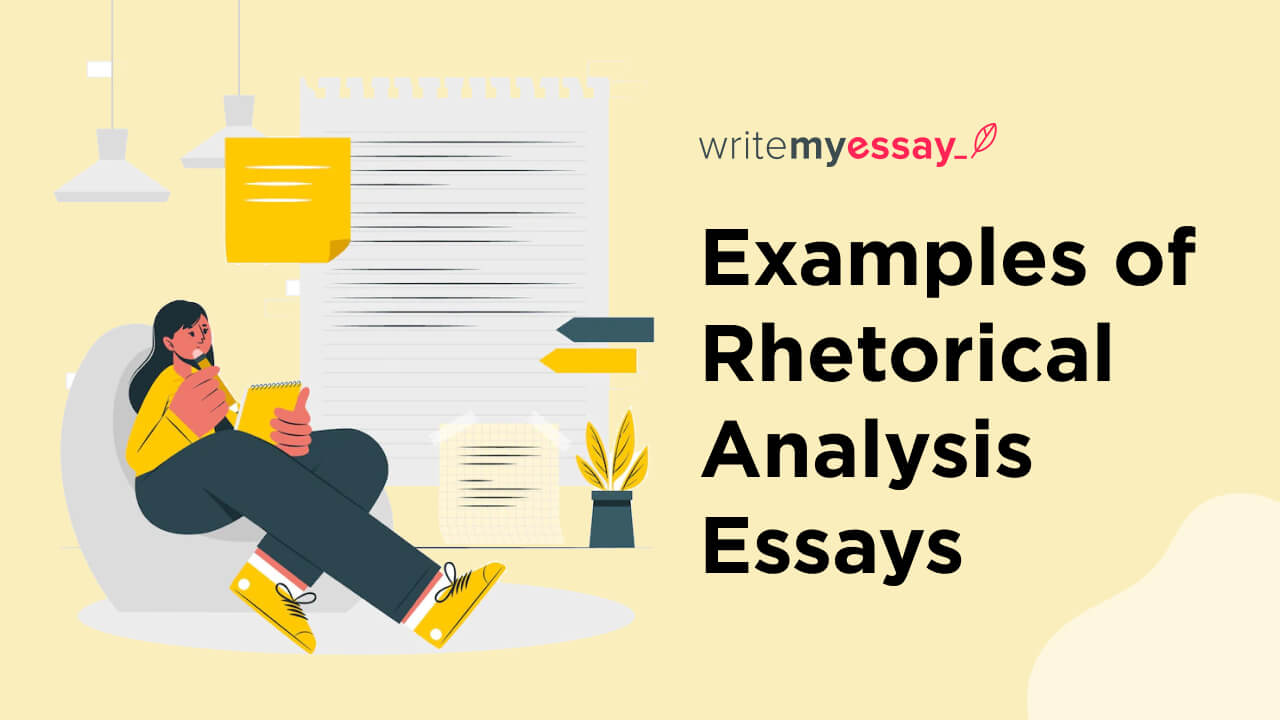
Examples of Rhetorical Analysis Essays

Table of Contents
Writing a rhetorical analysis essay is a great way to examine how an author effectively uses language to communicate their message. On a basic level, every piece of writing that is either explaining or shedding light on a particular matter can be termed as rhetorical. However, rhetorical analysis is about following a path and explaining the topic under consideration. The best use-case scenarios for rhetorical analyses include explaining a painting or a piece of art (more on that later). That’s the reason it is considered the best medium to explain diverse and complex ideas in a simple and easy-to-understand manner.
But writing a rhetorical essay and reaching your purpose with it is a daunting task, because of the multiple steps in the process and many known and unknown variables. In order to write an awesome rhetorical essay you need to see some examples and analyze how professional essay authors achieve their goals using Rhetorical Essays essays.
In this article, our experts from Write My Essay will share professional tips on how to write an awesome rhetorical essay. Keep reading to know everything.
What is a Rhetorical Analysis Essay?
A rhetorical analysis essay is an essay that examines the use of language and how it impacts a particular situation. It looks to identify and analyze the rhetoric used by a writer, speaker, or another form of communication to convey a message and understand its effects on the audience. A rhetorical analysis can also be used to uncover underlying messages and themes, as well as detect any potential biases.
In a Rhetorical Analysis Essay, you would analyze the rhetorical techniques used by an author or speaker to convey their message. For example, you could look at the organization and structure of an essay, the language choice, the intonation in a speech, or even the use of gestures.
Best Examples of Rhetorical Analysis Essays
Consider the following example: The president addressed Congress in a speech about climate change. In his speech, he used strong language to emphasize the need for action now: “We must act swiftly; we cannot delay!” He also appealed to emotion with stories of people affected by climate change, using words like “heartbreaking” and “despairing” to draw empathy for those affected. He framed his argument as a moral issue and concluded with a call to action.
In this example, the president deployed various rhetorical strategies such as strong language and appeal to emotion in order to make his point and convince his audience that immediate action is necessary. Through careful analysis of these elements, we can understand how effective this rhetoric was in persuading its audience.
Rhetorical Analysis Essay
Purpose of this essay: analyzing the speech given by Barack Obama at the Democratic National Convention in 2012.
Obama’s message was clear and effective in conveying his argument to the audience. He used several rhetorical strategies such as appeals to emotion and moral authority in order to persuade the audience of his point of view.
Obama began by stressing the importance of change and how it is essential for a better future. He highlighted how “change has never been easy,” but that it is “necessary” in order to make progress. He then appealed to the emotions of his audience by saying that they were part of something larger than themselves—the “American story,” which he described as one of “courage and determination, unity and faith.”
Next, Obama highlighted how the Democratic Party had initiated change during their time in office, citing specific examples such as healthcare reform, financial regulation reform, gay rights advances, and ending wars with dignity. This allowed him to both demonstrate why the change was necessary and also appeal to the moral authority of his party. To further drive home this point, he targeted Republicans by accusing them of telling Americans that they can no longer “dream big dreams” or have “(their) voice heard (in government).”
Finally, Obama called on his audience to take action so that America could remain a great nation despite its challenges. He reminded them “that we are greater together than we are on our own,” emphasizing unity over division in order to achieve their goals.
By masterfully using rhetoric throughout his speech, Barack Obama successfully convinced his audience that change is necessary for progress while uniting them behind a common cause—to ensure that America remains a great nation long into the future.
How to Write a Rhetorical Analysis Essay?
What is a Visual Rhetorical Analysis Essay?
A visual rhetorical analysis essay should focus on how an image’s meaning is interpreted by its audience. Analyze how the artist/creator used specific techniques such as color, symbols, shapes, and composition to convey a message or evoke certain emotions. Explain any specific elements that are essential to achieving the desired effect of the artwork and why they are important. Finally, make sure to connect your observations back to the overall purpose of the work and discuss how it affected its intended viewers.
Visual Rhetorical Analysis Essay Example
Here is an example of a Visual Rhetorical Analysis essay. Using this example you can also create a visual rhetorical analysis essay for yourself.
In this visual rhetorical analysis essay, I will analyze the painting “The Starry Night” (1889) by Vincent van Gogh. In this painting, van Gogh uses strong lines and bold colors to create deep emotion and beauty in his work. The painting features a village below a starry night sky, with swirls radiating out from a large yellow star. By drawing attention to the bright yellow star at the center of the canvas, van Gogh is able to create an intense focal point that immediately draws viewers in. Additionally, he uses short brushstrokes and cool colors to express feelings of tranquility and peace.
Through these methods, van Gogh conveys a sense of awe and respect for nature’s grandeur. He captures the intricate beauty of the night sky with its sparkling stars and sweeping vistas. At the same time, he highlights the smallness of human life by positioning a quiet village beneath it all. By doing so, he implies that despite our insignificance in comparison to nature’s larger forces – we can still find joy in its beauty and appreciate it from afar.
Overall, van Gogh succeeds in creating an emotionally captivating work of art that accurately reflects his admiration for nature’s eternal glory. His brilliant use of light and color effectively captures his fascination with natural magnificence while highlighting humanity’s place within it all; a reminder to us all that we can find solace in simply taking in nature’s wonders from afar.
Professional Tips on how to Write a Rhetorical Essay
These are some of the best rhetorical analysis essay writing tips that our experts from WriteMyEsssay use to create excellent Rhetorical Essays.
Choose a topic and format
Pick an interesting event, article, speech, or other text that you would like to analyze for your rhetorical essay. Consider the type of essay you will be writing and the best format for it (narrative, argumentative, expository, etc.).
Establish an argument
Determine what kind of response you want to elicit from your audience with your rhetorical essay. Outline an argument and make sure to back it up with evidence.
Research comprehensively
Gather as much information as possible on the subject matter and understand the context in which it was created or presented. Consider various authors’ opinions on the issue and incorporate them into your essay if relevant.
Analyze rhetorically
Examine how rhetoric is used to create a persuasive effect in the text. Look for ways that emotion is used to advance an argument as well as any logical fallacies present in the material being analyzed.
Write My Essay has been helping students and researchers with all their academic writing tasks for more than a decade. They have a team of experts who can create a plagiarism-free custom Rhetorical essay for you in just a few hours. They ensure that your essay is customized to your needs and is completely error-free. Write My Essay is offering a complete Rhetorical essay with a starting cost of just $12.95. If your essay deadline is approaching rapidly and you don’t have the time to complete it yourself then seek professional help right now and say goodbye to all your troubles!
F.A.Q
How do you write a rhetorical analysis example?
Writing a rhetorical analysis essay involves analyzing the persuasive techniques used in a text or speech, such as whether the author utilizes pathos (emotion), logos (logic), or ethos (credibility). To write such an essay, one must have a thorough understanding of the context and background information surrounding the subject matter.
How do I write a rhetorical analysis essay?
Here is how to write a rhetorical analysis essay:
- Gather as much relevant information on the subject matter.
- Understand the context in which it was created or presented.
- Take notes on key points such as language, tone, and choice of words
- include evidence from your research that supports your thesis statement.
- Try to create a persuasive effect on its audience.
- End with a conclusion that restates and supports your main argument.
What are the 3 parts of rhetorical analysis?
The three parts of rhetorical analysis are ethos, pathos, and logos.
- Ethos deals with the speaker’s or writer’s credibility.
- Pathos relates to emotions and how they affect the audience.
- Logos centers around logic and how arguments are framed.
What does a rhetorical analysis essay look like?
A rhetorical analysis essay typically begins with an introduction that includes a brief overview of the text or speech and its key points. In the body of the essay, each paragraph should include an analysis of one point in the text or speech. The conclusion should summarize the main argument and provide a synthesis of how ethos, pathos, and logos were used together to create a persuasive effect.


